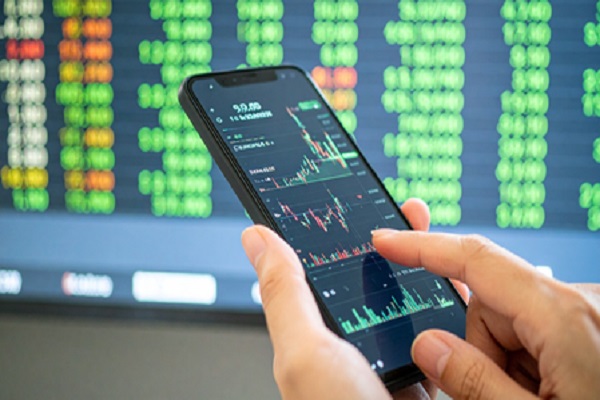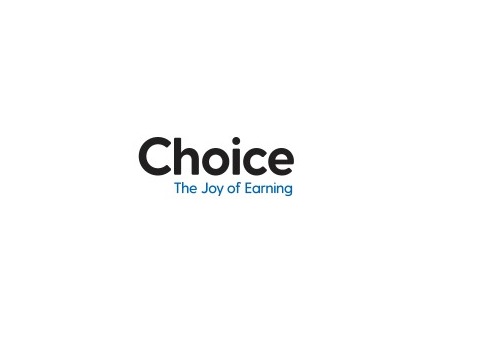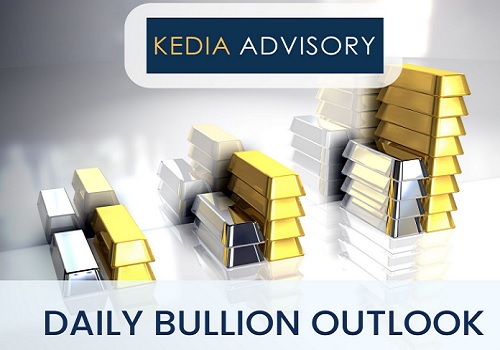Silver trading range for the day is 89970-93060 - Kedia Advisory

Gold
Gold surged by 2.48% to Rs.92,033, buoyed by strong safe-haven demand amid escalating US-China tensions. The sharp rally was triggered after President Trump unexpectedly hiked tariffs on Chinese imports to 125%, prompting a retaliatory move from Beijing, which raised duties on US goods to 84%. Despite broader global efforts at de-escalation, including the US lowering tariffs to 10% for a 90-day window, investor anxiety drove gold buying. Further boosting sentiment was the release of the FOMC minutes, highlighting policymakers' concerns about persistent inflation and slowing economic growth. Demand fundamentals remain strong, with the World Gold Council reporting Q1 inflows of 226.5 metric tons ($21.1 billion) into gold-backed ETFs. Central bank buying also continues unabated, led by China, which added to its reserves for the fifth consecutive month, taking total holdings to 73.7 million fine troy ounces by March-end. Retail demand in China remains robust due to geopolitical concerns, while Indian consumers are holding back in hopes of a price correction. Indian gold dealers offered discounts of up to $20 per ounce, slightly lower than last week's $33, signaling subdued demand. The World Gold Council projects India’s gold demand to moderate to 700–800 metric tons in 2025, down from a nine-year high of 802.8 tons in 2024, largely due to soaring prices curbing jewellery consumption. Technically, the market shows fresh buying interest, with open interest rising 9.32% to 19,415. Gold has support at Rs.91,160, with further downside testing possible at Rs.90,290. Resistance is seen at Rs.92,650; a break above may lead to Rs.93,270.
Trading Ideas:
* Gold trading range for the day is 90290-93270.
* Gold crosses 92000 first time ever as US-China trade flare-up.
* President Trump raised tariffs on Chinese imports to 125%, effective immediately.
* Broader trade de-escalation with 10% US duties for 90 days
Silver
Silver prices edged up by 0.49% to Rs.91,595, supported by safe-haven demand amid ongoing geopolitical tensions and favorable supply-demand fundamentals. The modest rise came as former President Trump reversed his tariff policy for most trade partners, reducing new import tariffs to 10% for a 90-day negotiation period. However, China remains subject to a steep 125% tariff, maintaining trade friction and uncertainty, which continues to bolster investor interest in precious metals like silver. FOMC minutes also highlighted concerns about stagflation and the potential negative implications of trade policy shifts on economic growth and inflation control. On the macro front, U.S. inflation eased for the second straight month to 2.4% in March 2025, down from 2.8% in February, fueling hopes that price pressures are moderating. Jobless claims remained relatively stable, with continuing claims dropping to 1.85 million, signaling resilience in the labor market. Fundamentally, the silver market is forecast to register its fifth consecutive annual deficit in 2025, estimated at 149 million ounces—down 19% from 2024 but still historically significant. Industrial demand remains a key pillar, projected to hit a record high, driven by green technologies and a 3% increase in physical investment. Technically, silver is witnessing fresh buying, with open interest up 1.05% to 20,613. Support is seen at Rs.90,785, with further downside potential to Rs.89,970. On the upside, resistance lies at Rs.92,330, and a breakout could push prices toward Rs.93,060.
Trading Ideas:
* Silver trading range for the day is 89970-93060.
* Silver prices rose after Trump’s reversal on his reciprocal tariff policy.
* Trump dropped new tariff rates on imports from most US trade partners to 10% for 90 days to allow for trade negotiations
* Minutes from the latest FOMC meeting revealed that most officials expressed concern over the risk of stagflation.
Crude oil
Crude oil prices declined by 1.82% to Rs.5,169, weighed down by escalating U.S.-China trade tensions and mounting fears of a global economic slowdown. Despite a brief lift from President Trump’s decision to pause tariff hikes for 90 days on most countries, the sharp increase in tariffs on Chinese imports to 125% has overshadowed market sentiment. With China being a top crude consumer, this tariff escalation raised concerns over reduced demand prospects. Supply-side developments provided mixed signals. The Keystone pipeline from Canada to the U.S. remains offline due to an oil spill, potentially tightening North American supply. Conversely, the Caspian Pipeline Consortium resumed partial operations at the Black Sea, easing some logistical constraints. Meanwhile, U.S. crude inventories increased by 2.553 million barrels, exceeding expectations and reinforcing bearish sentiment. Stocks at the Cushing hub also rose, while gasoline and distillate stockpiles fell by 1.6 million and 3.544 million barrels respectively, signaling robust fuel demand. On a global scale, the International Energy Agency (IEA) forecasts a crude surplus of 600,000 barrels per day in 2025, with the potential to rise if OPEC+ continues easing output cuts. The agency also trimmed its demand growth forecast by 70,000 bpd, citing weak consumption in late 2024 and early 2025 due to economic uncertainties. Technically, crude oil is under long liquidation, with open interest down 1.77% to 13,060. Support is seen at Rs.5,072 and further at Rs.4,976. Resistance lies at Rs.5,275, with a break above potentially testing Rs.5,382.
Trading Ideas:
* Crudeoil trading range for the day is 4976-5382.
* Crude oil dropped as escalated trade tensions between the US and China reignited demand concerns.
* Trump increased tariffs on Chinese imports to 125% from 104%, deepening a trade standoff.
* Crude inventories rose by 2.6 million barrels in the week to April 4, the Energy Information Administration said.
Natural gas
Natural gas prices dropped sharply by 5.22% to Rs.303.1, pressured by forecasts of milder weather and weaker demand over the next two weeks. The bearish sentiment was further fueled by broader declines across energy markets amid ongoing uncertainty surrounding U.S. President Donald Trump’s shifting tariff policies. Concerns over reduced global economic growth and energy demand due to trade tensions weighed heavily on prices. Traders noted that March likely saw a rare increase in gas storage due to mild conditions, with utilities potentially adding gas for the first time since 2012 in that month. Despite this, inventories remain about 3% below the seasonal norm due to heavy withdrawals in January and February, including record draws. Storage increased by 57 billion cubic feet (bcf) in the week ending April 4, slightly below expectations but significantly above both the five-year average and last year’s build. On the supply side, average daily production in April has dipped to 105.8 bcf, down from March's record of 106.2 bcf, with daily output recently hitting a six-week low of 103.4 bcf due to seasonal maintenance. Despite current softness, the U.S. Energy Information Administration projects record-high natural gas output and demand in 2025, with dry gas production expected to hit 104.6 bcf/day and LNG exports to rise to 14.0 bcf/day. Technically, the market is under long liquidation, as evidenced by a 0.68% drop in open interest to 11,476. Immediate support is seen at Rs.294.8, with a break below potentially testing Rs.286.4. Resistance lies at Rs.317.5, and a move above could push prices toward Rs.331.8.
Trading Ideas:
* Naturalgas trading range for the day is 286.4-331.8.
* Natural gas slid on forecasts for mild weather and lower demand over the next two weeks.
* US LNG export feedgas on track to hit record high in April
* US gas output on track to slide in April from March record
Copper
Copper prices edged higher by 0.6% to Rs.827.2, supported by optimism stemming from U.S. President Trump’s decision to pause his reciprocal tariff package for 90 days. Although copper was initially exempt from the tariff scope, the broader move to lower duties on non-retaliating countries helped ease recession fears and boosted expectations of renewed manufacturing activity in the U.S., a key driver for copper demand. However, the intensifying trade conflict between the U.S. and China, marked by higher tariffs from both sides, disrupted the regular flow of copper scrap exports from the U.S. to China—potentially tightening secondary copper supply and supporting prices. On the global supply front, Japan’s refined copper output is forecast to decline 1.3% in the first half of FY 2025/26 due to weak demand from the wire and cable segment, even as demand for copper alloy products shows resilience. Goldman Sachs issued a cautious outlook, predicting copper prices to average $8,300 per metric ton in Q3 2025, citing downside risks if industrial production deteriorates more than GDP amid ongoing uncertainty. The ICSG reported a refined copper market deficit of 19,000 metric tons in January, slightly narrower than December’s shortfall. Chinese unwrought copper imports fell 7.2% y-o-y to 837,000 tons in the first two months of 2025, reflecting higher domestic smelting capacity. Technically, copper is under short covering as open interest dropped 4.38% to 5,322. Support is at Rs.822.1, with a break lower testing Rs.817.1, while resistance is seen at Rs.832.3, with a move above targeting Rs.837.5.
Trading Ideas:
* Copper trading range for the day is 817.1-837.5.
* Copper rallied after US President Trump paused his reciprocal tariff package for 90 days.
* Manufacturing outlook improves as US delays 10% tariff hikes
* Japan’s H1 FY25/26 refined copper output seen down 1.3%
Zinc
Zinc prices rose by 0.68% to Rs.252.6, buoyed by a temporary easing in trade tensions after U.S. President Trump announced a 90-day pause on most recently imposed tariffs, lifting market sentiment. However, this relief was tempered by the sharp increase in tariffs on Chinese imports to 125%, further escalating tensions with the world’s largest base metals consumer. Despite these geopolitical shifts, zinc found support from tightening supply-side fundamentals and declining inventories. LME data revealed that zinc stocks dropped by 1,350 tons, primarily from Singapore, reinforcing signs of constrained availability. Citi Research revised its 2025 zinc price forecast downward to $2,630/t from $2,750/t, citing weaker demand due to escalating trade barriers. Meanwhile, the global zinc market deficit narrowed to 10,000 metric tons in January, down from 41,100 tons in December, as China’s refined zinc production rose by 1.8% year-on-year over January-February. Supply disruptions remain a key theme. Nyrstar’s 25% output cut at its Hobart smelter in Australia and anticipated slowdowns at the Red Dog Mine in Alaska—contributing roughly 10% to global output—pose potential support for prices. In China, February refined zinc production fell over 4% YoY, with a cumulative decline of 6% for the January-February period. Technically, zinc is in a short covering phase, with open interest falling by 6.44% to 2,657. Immediate support is at Rs.251.3, with a drop below leading to Rs.249.9. Resistance is seen at Rs.254.5, and a breakout could push prices towards Rs.256.3.
Trading Ideas:
* Zinc trading range for the day is 249.9-256.3.
* Zinc prices rebounded sharply after most U.S. tariffs were paused for 90 days.
* LME data showed zinc stocks fell by 1,350 tons, or 1.10%, to 121,800 tons.
* Data provided further evidence of a shaky Chinese economy, as consumer prices fell for the second straight month
Aluminium
Aluminium prices gained 0.73% to settle at Rs.233.9, supported by improved sentiment after U.S. President Donald Trump temporarily suspended his recently imposed tariffs for 90 days. This unexpected move helped soothe markets following a severe rout, although Trump maintained pressure on China by threatening to raise tariffs to 125%, intensifying trade tensions with the world’s top aluminium consumer. Inventory dynamics also supported prices, with LME aluminium stocks dropping by 3,175 tonnes to 446,325 tonnes. The most notable reduction came from Port Klang, which saw a drawdown of 2,000 tonnes, indicating tight near-term supply. While global aluminium output in February fell 0.9% year-on-year to 5.645 million tonnes, Chinese production remains robust. China produced a record 44 million tonnes of aluminium in 2024 and added 2.6% year-on-year growth in January-February 2025 due to improved profitability at smelters, thanks to easing alumina supply constraints and falling input costs. Despite the increase in Chinese output, Beijing’s long-standing cap of 45 million tonnes could trigger a production slowdown later this year, aligning with China’s carbon neutrality goals. On the demand side, China’s exports of unwrought aluminium and aluminium products rose 17% year-on-year in the first ten months of 2024, reflecting resilient global demand. Technically, the market is in a short covering phase, with open interest dropping by 0.55% to 3,794 as prices climbed Rs.1.7. Aluminium now finds support at Rs.232.6, with further downside risk to Rs.231.3, while resistance is seen at Rs.235.2, and a breakout could target Rs.236.5.
Trading Ideas:
* Aluminium trading range for the day is 231.3-236.5.
* Aluminium prices gained on tariff pause, tightening LME stocks
* LME data showed that aluminium stocks fell by 0.71%, to 446,325 tons.
* Global primary aluminium output in February fell 0.9% year on year to 5.645 million tonnes.
Cottoncandy
Cottoncandy prices settled lower by 0.36% at Rs.54,600 due to profit booking after a brief rally sparked by bullish U.S. planting estimates. The USDA reported a 12% year-on-year decline in intended U.S. cotton acreage to 9.8 million acres for 2025, signaling tighter supply expectations. Domestically, the Cotton Association of India (CAI) further cut its 2024-25 crop estimate to 295.30 lakh bales (170 kg each), down from 301.75 lakh bales, driven by a nearly 10% decline in planted area and reduced output in key states like Gujarat and Maharashtra. Imports are expected to double this season to 32 lakh bales, compared to 15.20 lakh bales last year, reflecting the domestic supply gap. While consumption remains steady at 315 lakh bales, exports are forecast to plunge 40% to 17 lakh bales, pressured by competitive global supply and weak international demand. CAI estimates end-season stocks to drop to 23.49 lakh bales, down from 30.19 lakh bales last year, adding to the overall tighter domestic balance sheet. On the global front, Brazil’s cotton output is projected to rise by 1.6% to 3.76 million tonnes, supported by a 4.8% increase in acreage. However, mills remain well-stocked, and their restrained buying is expected to limit upside movement in the near term. Technically, the market is under long liquidation, with open interest falling by 0.4% to 247 as prices eased Rs.200. Cottoncandy has support at Rs.54,600, with further weakness likely toward Rs.54,400, while resistance is seen at Rs.54,800, and a move above may lead to testing Rs.55,000.
Trading Ideas:
* Cottoncandy trading range for the day is 54600-54600.
* Cotton dropped on profit booking after prices gained as USDA report showed lower-than-expected U.S. planting estimates.
* USDA's planting intentions report showed U.S. all-cotton intended planting of 9.8 million acres for 2025, a 12% reduction from 2024.
* CAI has further reduced its 2024-25 crop estimate by 2 per cent to 295.30 lakh bales.
* In Rajkot, a major spot market, the price ended at 25592.25 Rupees dropped by -0.36 percent.
Turmeric
Turmeric futures fell by 0.93% to settle at Rs.14,122, retreating on profit booking after recent price gains driven by tight supply and robust demand. Despite the dip, overall sentiment remains firm due to constrained arrivals and strong buying interest, especially supported by bullish export trends. Exports surged by 12.93% year-on-year during April–January 2025, reaching 1.49 lakh tonnes — the highest volume in four years, surpassing even the 2020 levels. Although January exports dipped by over 23% from December, they were still up by 12.18% from January 2024, indicating sustained international demand. Production concerns are also lending support to prices. While the area under turmeric cultivation increased by 10% this season to 3.30 lakh hectares, production is unlikely to rise in tandem due to untimely rains, which are expected to impact yields adversely. Key growing regions like Nanded are reportedly facing issues like small rhizomes and crop rot, with projected yield losses of 10-15%. As harvesting gains momentum, a clearer picture will emerge. Last year's production was 10.75 lakh tonnes, and this season's output may stay flat or vary marginally by 3-5%. Technically, the market is under fresh selling pressure, with a 6.08% increase in open interest to 11,435 contracts. Turmeric has support at Rs.13,672, and a breach below could test Rs.13,220. Resistance is seen at Rs.14,438, and a move above this may push prices towards Rs.14,752.
Trading Ideas:
* Turmeric trading range for the day is 13220-14752.
* Turmeric dropped on profit booking after prices gained as lower-than-expected arrivals restricted supplies.
* Exports continued to pick up in the second half of 2024, with shipments reaching a four-year high.
* New crop yields are expected to be 10-15% lower this year, with the Nanded region particularly affected.
* In Nizamabad, a major spot market, the price ended at 14187.45 Rupees dropped by -0.95 percent.
Jeera
Jeera prices slipped by 1.66% to settle at Rs.24,290 amid profit booking after recent gains driven by steady domestic demand and robust export activity, especially from Gulf countries. Despite supportive fundamentals, the market witnessed a correction as supply constraints began easing gradually. Arrival pressures remained muted in Rajasthan, but the new crop from Gujarat has seen a delay of about a month due to adverse weather conditions impacting the sowing timeline. Fundamentally, India remains the most competitive cumin supplier globally, with domestic prices hovering around $3,050 per tonne, while Chinese cumin commands a premium of $200–250. This price advantage has bolstered Indian exports, with jeera shipments rising sharply by 66.98% to 1.82 lakh tonnes during Apr–Jan 2025 compared to the same period last year. Although January 2025 exports dipped slightly by 5.5% month-on-month, they surged 37.82% year-on-year, reflecting sustained global demand. On the supply side, India’s cumin production rose to 8.6 lakh tonnes in 2023–24 from over 11.87 lakh hectares, up from 5.77 lakh tonnes a year earlier. However, demand has been slow, and only 3–4 lakh of the 20 lakh bags of cumin held by farmers are expected to be traded this season, indicating a sizeable carry-forward stock of 16 lakh bags. Technically, jeera is under fresh selling pressure, with open interest rising 12.66% to 5,955 contracts as prices declined Rs.410. Support is now seen at Rs.23,920, and a break below could test Rs.23,530. Resistance is likely at Rs.24,710, with a move above paving the way for a test of Rs.25,110.
Trading Ideas:
* Jeera trading range for the day is 23530-25110.
* Jeera dropped on profit booking after prices gained amid price support from domestic demand, as well as export activity.
* The current season is expected to have similar production levels as last year due to better crop conditions and good sowing.
* Jeera exports during Apr - Dec 2024, rose by 70.72 percent at 165,084.40 tonnes as compared to 96,701.43 tonnes exported during Apr- Dec 2023.
* In Unjha, a major spot market, the price ended at 24514.85 Rupees gained by 0.25 percent.
Views express by all participants are for information & academic purpose only. Kindly read disclaimer before referring below views























